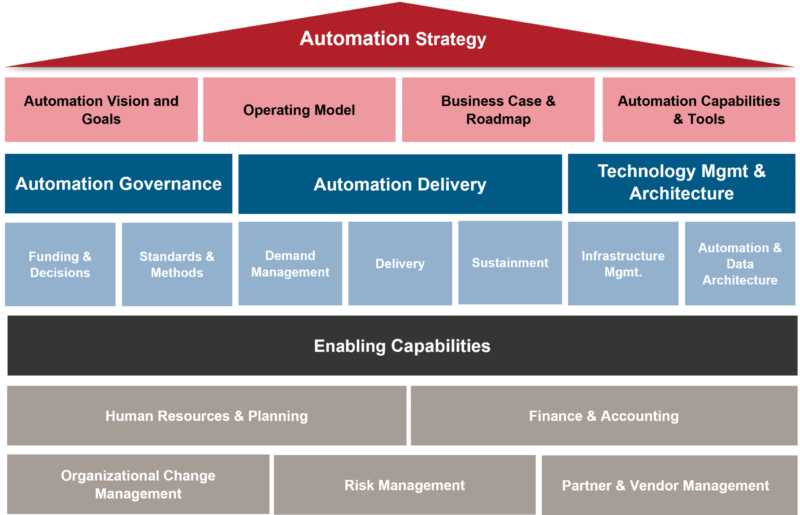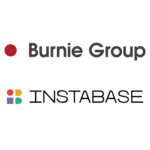
Intelligent automation has emerged as a transformative technology that streamlines operations, enhances efficiency, and reduces costs. However, as organizations embark on their automation journeys, they often face challenges with scaling their automation beyond the initial implementation. Where organizations have been successful in achieving scale, they often find it hard to manage their existing automation to ensure consistent benefits. In addition, automation centers of excellence (COEs) are under pressure to develop perspectives and capabilities to connect with broader artificial intelligence (AI) tools and become integral parts of new product and service offerings.
Key takeaways
-
Many automation programs stall without a clear strategy, governance, and scaling plan
-
A recurring problem is lack of maintenance, process discovery, and employee engagement
-
Regular assessment using a maturity framework helps ensure sustainable automation and maximize ROI
This article delves into the current issues affecting automation COEs and highlights the importance of assessing and revisiting your automation model. We will also introduce a framework we successfully deployed to measure our client’s ability to scale and identify opportunities for improvement.
6 current issues affecting automation COEs at organizations
In the pursuit of harnessing the advantages of robotic process automation (RPA) and broader automation tools, organizations frequently encounter several barriers that impede the efficiency of their centers of excellence. These challenges include:
- Absence of a clear strategy: Many organizations dive into RPA implementations without a well-defined strategy, leading to fragmented efforts, duplicated processes, unclear division of duties, and inadequate alignment with overarching business objectives. Implementing without a strategy is further complicated by advancements in AI as organizations move towards higher-level AI capabilities that can integrate with RPA, such as large-language models, optical character recognition, intelligent document processing, and machine learning.
- Insufficient governance and prioritization: In the absence of proper governance, managing an increasing number of automation projects becomes a dizzying and daunting task. It can result in suboptimal processes, security vulnerabilities, poor use of teams, overspending on infrastructure, focusing on the wrong things, and challenges in monitoring automation performance.
- Uncoordinated automation support and maintenance: Process automation introduces maintenance challenges due to the dynamic nature of business processes, technology and operational environments. As automation scales within an organization, support and maintenance requirements increase. Organizations often find themselves unprepared to deal with this sudden demand, significantly impacting their automation initiatives’ effectiveness and long-term success.
- Absence of a defined process discovery approach: Following the successful deployment of the initial set of identified processes, COEs sometimes struggle to maintain a consistent pipeline of processes for automation. As a result, the automation program can come to a standstill.
- Lack of employee support: Resistance to change and a lack of employee engagement can hinder RPA adoption. Employees might be apprehensive about job displacement or uncomfortable with the new technology.
- Boxed-in architectures: Upgrading existing RPA can be complex, particularly for early adopters of RPA. Connecting with more modern integration methods can require upgrades to the base infrastructure, which is particularly challenging for more extensive portfolios. However, these upgrades are essential to enabling connectivity with broader AI capabilities within the same suite or accessing best-of-breed tools.
The importance of reassessing your automation model
Given the complexities and challenges associated with automation implementation, organizations must regularly assess and revisit their automation model for the following reasons.
- Continuous improvement: The business landscape is dynamic, and so are the processes within it. Regularly assessing your automation models enables your organization to identify bottlenecks, inefficiencies, and areas for improvement in your automation initiatives.
- Better alignment with business goals: An automation strategy that was effective in the initial stages might not align with your organization’s evolving goals. Regular assessment ensures that automation efforts align with your strategic objectives.
- Optimized resource utilization: It is critical to regularly review and identify skill gaps and resource allocation issues to enable effective resource allocation and prioritize skill development where needed.
- Maximized ROI: Automation initiatives require substantial time, money, and effort. Regular assessments of your center of excellence model ensure that these investments yield the desired returns by focusing on efficiency, effectiveness and integration of cutting-edge automation advancements.
- Evolving operating model: Often, automation initiatives begin with small, ad-hoc teams within Business or IT. As the scale of the program evolves, the operating model must evolve to deliver maximized benefits. Whether the COE is centralized, federated, or hybrid, there is no one-size-fits-all approach to scaling. It is important to choose a model that aligns with your organizational structure and the maturity of your automation program.
Organizations must periodically step back, assess, and refine their automation capability and delivery models to overcome these challenges and ensure a sustainable automation center of excellence. By doing so, your organization can unlock the true potential of intelligent automation while driving significant value across the enterprise, aligning with organizational strategy and operating norms while effectively managing risk.
Burnie Group’s automation maturity framework

Leveraging a framework to assess your automation COE provides structure, consistency, and clear guidance. Our automation maturity framework is based on an industry-agnostic model developed by CMMI and leading technology frameworks tailored for automation. Our framework has five key pillars:
Strategy
An effective strategy aligns with organizational goals and defines the operating model. Using your strategy to identify automation initiatives ensures there is a viable business case for automation opportunities. The strategy should clearly define program metrics and measure value realization to support your organization’s growth of automation capabilities.
Governance
Governance defines roles and responsibilities, funding, and decision-making processes within the COE to effectively oversee automation implementations. It ensures that there is clear accountability and strategic alignment throughout the programs.
Delivery
Delivery encompasses the entire lifecycle of RPA projects, from initial planning and development to testing, deployment, and ongoing maintenance. Effective delivery streamlines business processes, improves operational efficiency, and achieves the intended outcomes of automation initiatives.
Technology management and architecture
Technology management and architecture encompass the practices and methodologies used to oversee and optimize RPA implementations within an organization. It involves managing technical aspects of RPA solutions and designing the architecture that underpins the automation infrastructure.
Enabling capabilities
Enabling capabilities encompass all other key supporting areas required for implementing automation in alignment with broader enterprise practices. These capabilities include change management, procurement, risk management, human resources, and finance.
Using the framework to assess your COE
We assess an automation COE’s maturity on a scale of 0 – 5 across each of the key pillars identified in our framework. The guidelines for each of the levels are as follows:
- Level 0 – Ad hoc and unknown: No existing defined guidelines for an automation COE, and no work in progress or completed to build one.
- Level 1 – Unpredictable and reactive: No defined guidelines in place. Automation work is started and completed but is often delayed or over budget.
- Level 2 – Managed at the project level: Guidelines exist, but they are not consistently followed. Projects are planned, performed, measured, and controlled.
- Level 3 – Proactive: Organization-wide standards exist as guidance across projects, programs and portfolios.
- Level 4 – Measured and controlled: The organization is data-driven with quantitative performance improvement objectives that are predictable and align to meet the needs of internal and external stakeholders.
- Level 5 – Stable and flexible: The organization is focused on continuous improvement and can quickly pivot and respond to opportunity and change. The organization’s stability provides a platform for agility and innovation.
The automation maturity framework, along with the assessment criteria above, will identify areas of strength and uncover significant opportunities for improvement to balance the maturity of your COE for whatever scale of automation capability you need.
How Burnie Group supports automation centers of excellence
Burnie Group has worked with organizations to design, execute, and continuously improve automation centers of excellence for the past decade. Our automation maturity framework has been critical in driving enhancements and improvements to COEs. Embracing the adage “Change is the only constant,” our framework continuously evolves as we incorporate insights gleaned from our client engagements.
If you are an established automation leader looking for support in propelling your team forward or you are new to the game and need help determining where to start, contact us.
Frequently asked questions
What is the risk of implementing automation without a clear strategy or governance?
When organizations deploy automation without a clear strategy or proper governance, they often end up with disjointed or redundant automation efforts. Without defined roles, priorities, and alignment with business objectives, processes may be duplicated, resource allocation becomes inefficient, and there is little control or visibility over automation performance, especially as the scope of automation expands. Over time, this can lead to wasted investments, maintenance burdens, and failure to deliver anticipated benefits.
Why do many automation projects fail to scale or sustain over time?
Many initial automation successes falter because organizations don’t plan for ongoing process discovery, maintenance, and employee buy‑in. After automating a first set of processes, they may lack a structured methodology to identify new automation opportunities, or lack resources to maintain and support existing automations. Additionally, if employees are not engaged, perhaps due to fear of job loss, unclear roles, or poor change management, adoption suffers. As a result, the automation program stalls or regresses instead of evolving.
How does the automation maturity framework from Burnie Group help organizations improve their automation efforts?
The maturity framework proposed by Burnie Group assesses a COE across five dimensions: strategy, governance, delivery, technology & architecture, and enabling capabilities (e.g. change management, HR, risk, finance). By rating maturity on a scale (from ad hoc/unknown up to stable and flexible), organizations can pinpoint where they’re weak, whether it’s lack of clear alignment, poor governance, suboptimal technology architecture, or inadequate support processes. This structured assessment enables organizations to build a roadmap for improvement, allocate resources strategically, align automation with business goals, and maximize return on automation investment.
About the authors
Read more our insights on automation
Find out how we can support your organization with building and maintaining an automation center of excellence.
CONTACT US




